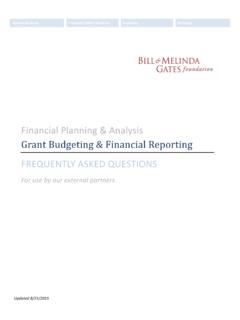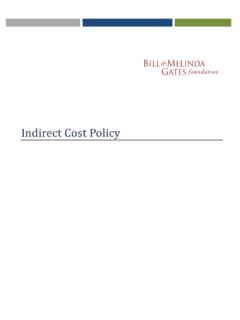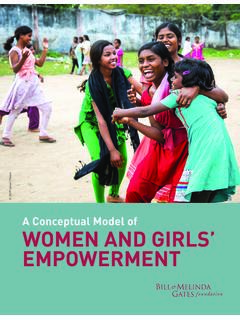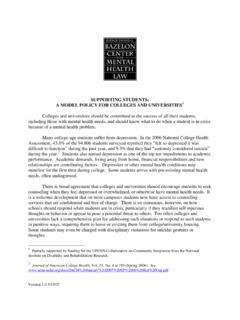Transcription of Supporting Students - Bill & Melinda Gates Foundation
1 COLLEGE-READY WORK MONOGRAPHSS upporting Students Investing in Innovation and QualitySupporting Students Investing in Innovation and QualityMuch of the current debate over how to improve education focuses on creat-ing high standards and finding fair and reliable new ways to measure student achievement and to assess teacher performance. All of these, in our view, are good often, however, the debate stops there and doesn t address the kinds of opportunities and supports that Students need to achieve our ambitious goal of 80 percent of young people college-ready by College Ready Work Team at the Bill & Melinda Gates Foundation has focused its investments on supports for both teachers and Students .
2 In other monographs, we have described our teacher-supports investments. In this monograph, we describe how we have been thinking about student supports. There is no common definition of student supports within the education field. At their broadest, student supports encompass all programs and services that help Students navigate their lives from tutoring programs to life-skills training, such as early parenting classes. 1supportIng Students : InvestIng In InnovatIon and QualItyBecause the definition is so broad, we have limited our investment scope to academic supports.
3 Our goal is to dramatically increase the number of college-ready Students by focusing on what they need and changing the systems and policies that are preventing schools, districts, and states from producing large numbers of college-ready have been thinking in very nontraditional ways. In some cases, this means investing in game-based applications and assessments that can be used anytime, anywhere. In other cases, this means investing in research to better understand college-access and student-persistence issues. In every instance, our intention is the same: to make tools and successful strategies widely available to schools and districts at little or no cost.
4 The portfolio is evolving as we learn more about scalable solutions from our grantees. This brief monograph describes some of our early thinking and some of our current WongDeputy Director, Education Bill & Melinda Gates 2supportIng Students : InvestIng In InnovatIon and QualItyTitle subBy any measure, too many Students are leaving school without the knowledge and skills they need to succeed and thrive. Some drop out; others graduate but are still far from ready for either college or a career. And within schools, too many Students are simply bored and disengaged. They don t see the relevance of their assignments to their lives and rarely have an opportunity to master their s Students grow up with cutting-edge technology through the Internet: YouTube, instant messaging, and so-cial networking.
5 They are electronically tethered to informa-tion, services, entertainment, and each Yet in their classrooms, too many of them face instructional practices that were outdated even when their parents were in school. It doesn t have to be this way. At the Gates Foundation , we envision a future where stu-dents learn beyond the bounds of traditional classrooms, where they set their own pace toward college readiness, and get there, at least in part, by pursuing their own we consider investing in a dramatically different way of learning, we re asking questions like this: How can Students engage in solving complex problems that are relevant to their lives?
6 How can classroom design lead Students to deep and enduring mastery of their schoolwork and skills? How can we capitalize on their digital prowess to in-spire confidence, curiosity, persistence, and a desire for knowledge?Many of our grantees have drawn inspiration from the practices and tools used in the professional world, includ-ing medicine, the arts, and corporations large and small. Their learning programs are often digital and are marked by being participatory, engaging, cocreative, and highly the 3supportIng Students : InvestIng In InnovatIon and QualItyDesign PrinciplesIt is easy to get lost in some of the many new technological possibilities.
7 It is not enough for potential investments to be cleverly en-gaging; they must also deliver solutions for Students that produce high-quality results. We must keep the end firmly in mind: true college and career readiness for our na-tion s young the College Ready Work Team has ap-proached investments in student supports, it has developed a set of design principles to guide its decisions. These values are based on research about learning science and in-clude the following:1. Mastery. Learning solutions units, courses, and sub-jects should have clear progress trajectories from novice through apprentice to mastery.
8 Students should un-derstand how to advance from one level to the Feedback. Learning solutions should give Students im-mediate feedback on their performance. The work should offer repeated opportunities to try different approaches, to improve their results, and to demonstrate Subject Immersion. Learning solutions should immerse Students in the discourse, tools, and culture of the sub-jects studied. For example, Students should learn mathemat-ics by using the metrics and analytical tools of mathematicians, and by articulating the choices they make to solve a problem. Science Students should be engaged in inquiry, data gather-ing, and analysis, and should build arguments based on valid evidence.
9 Learning solutions should enable Students to learn to be mathematicians, historians, or biologists rather than just to learn about these subjects. 4 Supporting Students : InveStIng In InnovatIon and QualIty4. Multiple experiences. Learning solutions should offer Students varied and diverse opportunities to apply knowledge and skills, and to produce not just consume content. Learning solutions should be designed for anytime, anywhere learning. A masterful basketball player, for example, moves from drills to scrimmages to one-on-one coaching to competitive games, each exercise providing new ways of developing mastery.
10 This example implies that learning content in one setting a typical 50- minute-long classroom period is not sufficient for acquir-ing, practicing, and applying necessary Multimedia. Learning solutions should employ digital resources simulations, videos, video conferencing, games, interactive maps, data-analysis software, and vir-tual worlds as an integral part of the learning ex perience. Students should be able to use these digital resources as tools to support their 5supportIng Students : InvestIng In InnovatIon and QualIty1. Proficiency-Based Pathways A Growing portfoliothe Foundation s portfolio of investments in student supports is intention-ally diverse.

















